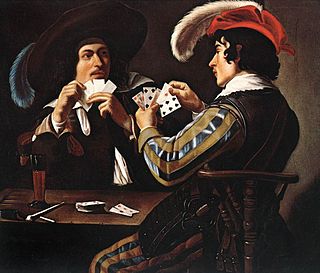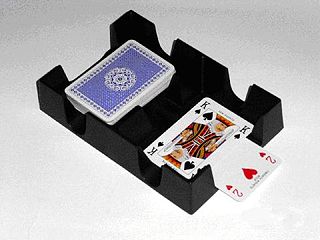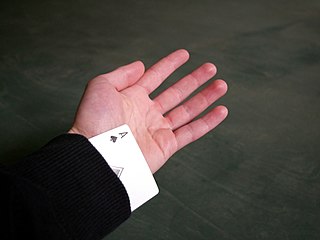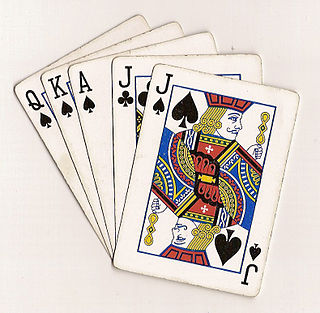Related Research Articles

Blackjack is a casino banking game. It is the most widely played casino banking game in the world. It uses decks of 52 cards and descends from a global family of casino banking games known as Twenty-One. This family of card games also includes the European games Vingt-et-Un and Pontoon, and the Russian game Ochko. Blackjack players do not compete against each other. The game is a comparing card game where each player competes against the dealer.

A card game is any game using playing cards as the primary device with which the game is played, be they traditional or game-specific. Countless card games exist, including families of related games. A small number of card games played with traditional decks have formally standardized rules with international tournaments being held, but most are folk games whose rules may vary by region, culture, location or from circle to circle.

Shuffling is a procedure used to randomize a deck of playing cards to provide an element of chance in card games. Shuffling is often followed by a cut, to help ensure that the shuffler has not manipulated the outcome.

In card games, to cut the cards is to split the deck into two packets by lifting one packet from the top and placing it face down beside the remainder; before placing the lower packet on top of it. This is typically done after the cards have already been shuffled, and the procedure is used just prior to the cards being dealt to the players. The aim of this is to reduce the possibility of cheating, for example, by knowing the bottom card. Cutting the cards is also a common way of determining the seating order at a card table, the partnerships or the first dealer.

Pinochle, also called pinocle or penuchle, is a trick-taking, Ace-Ten card game typically for two to four players and played with a 48-card deck. It is derived from the card game bezique; players score points by trick-taking and also by forming combinations of cards into melds. It is thus considered part of a "trick-and-meld" category which also includes the game belote. Each hand is played in three phases: bidding, melds, and tricks. The standard game today is called "partnership auction pinochle".

Sheepshead is an American trick-taking card game derived from Bavaria's national card game, Schafkopf. Sheepshead is most commonly played by five players, but variants exist to allow for two to eight players. There are also many other variants to the game rules, and many slang terms used with the game.

Cheating in poker is any behavior outside the rules of poker that is intended to give an unfair advantage to one or more players.

Faro, Pharaoh, Pharao, or Farobank is a late 17th-century French gambling game using cards. It is descended from Basset, and belongs to the Lansquenet and Monte Bank family of games due to the use of a banker and several players. Winning or losing occurs when cards turned up by the banker match those already exposed.

Card counting is a blackjack strategy used to determine whether the player or the dealer has an advantage on the next hand. Card counters are advantage players who try to overcome the casino house edge by keeping a running count of high and low valued cards dealt. They generally bet more when they have an advantage and less when the dealer has an advantage. They also change playing decisions based on the composition of the deck.

A card sharp is a person who uses skill and/or deception to win at poker or other card games. "Sharp" and "shark" spellings have varied over time and by region.
Cheating in casinos refers to actions by the player or the house which are prohibited by regional gambling control authorities. This may involve using suspect apparatus, interfering with apparatus, chip fraud or misrepresenting games. The formally prescribed sanctions for cheating depend on the circumstances and gravity of the cheating and the jurisdiction in which the casino operates. In Nevada, for a player to cheat in a casino is a felony under Nevada law. In most other jurisdictions, specific statutes do not exist, and alleged instances of cheating are resolved by the gambling authority who may have more or less authority to enforce its verdict.
Bottom dealing or base dealing is a sleight of hand technique in which the bottom card from a deck of playing cards is dealt instead of the top card. It is used by magicians as a type of card illusion, and by card sharps and mechanics, and as a method of cheating in poker or other card games.

Craits is a shedding card game for two to five players. It was invented in the 1970s in Cambridge, Massachusetts, and is derived from Crazy Eights, which forms the origin of its name.
Sueca is a 4 player-partnership point trick-taking card game of the Ace-Ten family, and a popular variant of the Bisca card game. The game is played in Portugal, Brazil, Angola and other Portuguese communities. Its closest relative is the very similar German game Einwerfen.

A poker dealer distributes cards to players and manages the action at a poker table.

A dealing shoe or dealer's shoe is a gaming device, mainly used in casinos, to hold multiple decks of playing cards. The shoe allows for more games to be played by reducing the time between shuffles and less chance of dealer cheating. In some games, such as blackjack, using multiple decks of cards can increase the house edge.
In card games, hole carding is the obtaining of knowledge of cards that are supposed to be hidden from view. The term is usually applied to blackjack but can apply to other games with hidden hole cards, like three card poker and Caribbean stud poker. So long as it does not involve the use of a device like a mirror or actions like touching the dealer's cards, in most jurisdictions hole carding is a legal form of advantage gambling. In some games, like stud poker, casinos normally have rules against rubbernecking or having a confederate stand behind an opponent to signal hole cards.
The following is a glossary of poker terms used in the card game of poker. It supplements the glossary of card game terms. Besides the terms listed here, there are thousands of common and uncommon poker slang terms. This is not intended to be a formal dictionary; precise usage details and multiple closely related senses are omitted here in favor of concise treatment of the basics.

The following is a glossary of terms used in the card game blackjack. This is not intended to be a formal dictionary; precise usage details and multiple closely related senses are omitted here in favor of concise treatment of the basics.

The card game of Euchre has many variants, including those for two, three, five or more players. The following is a selection of notable Euchre variants.
References
- John Nevil Maskelyne, Sharps and Flats. ISBN 0-87019-049-0